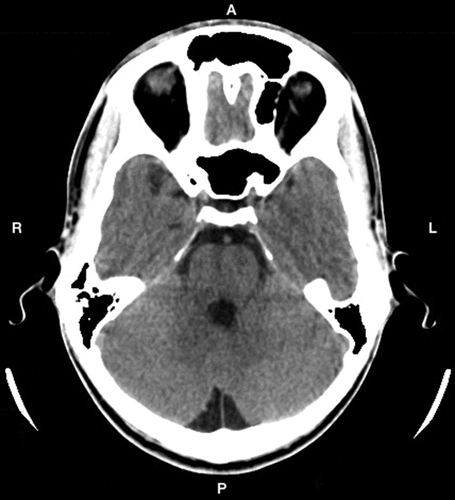Increased Sensitivity to Atypical Antipsychotics in a Patient With Dandy-Walker Variant With Schizophrenia
To the Editor: Dandy-Walker variant, characterized by cerebellar hypoplasia without marked expansion of the posterior fossa, has been classified as a continuum of Dandy-Walker malformation. We report a case of a Dandy-Walker variant in association with schizophrenia, in which there was worsening of tardive dyskinesia with low doses of atypical antipsychotics.
The Dandy-Walker malformation is a congenital brain malformation characterized by cystic dilatation of the fourth ventricle, dysgenesis of the cerebellar vermis, and higher position of tentorium.1 Less severe conditions, such as Dandy-Walker variant (cerebellar hypoplasia without marked expansion of the posterior fossa), and mega cisterna magnum (expanded posterior fossa with relatively minor hypoplasia of the cerebellum) have been classified as a continuum of Dandy-Walker malformation and named as “Dandy-Walker complex.”1 Various neuropsychiatric disorders have been reported with Dandy-Walker complex, such as schizophrenia-like psychosis, obsessive-compulsive disorder, and bipolar disorder.2–6 We report a case of a Dandy-Walker variant in association with schizophrenia; this patient had worsening of tardive dyskinesia with low doses of atypical antipsychotics.
Case Study
“Mr A.,” a 20-year-old man, presented with a history of smiling and muttering to himself, remaining aloof, with occasional abusive and aggressive behavior, and not doing any work for the past 6 years. He was treated with several typical antipsychotics previously without much benefit. He had had an episode of febrile convulsion at 2 years of age, and one younger brother had seizure disorder. Mental status examination revealed silly smiling, with inappropriate affect. On physical examination, he had fine peri-oral dyskinetic movements associated with pouting movements seen infrequently over the lips. The score on the Abnormal Involuntary Movement Scale (AIMS)7 was 4. There were no other neurological signs. His blood investigations, including hemogram, liver and renal function tests, blood sugar, lipid profile, serum electrolytes, and thyroid function tests were normal. Considering a diagnosis of schizophrenia with drug-induced dyskinesia, he was put on olanzapine, an atypical antipsychotic, at 10 mg per day, but peri-oral dyskinetic movements increased in frequency within a few days. Olanzapine was discontinued, and he was put on aripiprazole 10 mg per day, with which he showed improvement in psychotic symptoms, but involuntary movements persisted. Aripiprazole was gradually reduced to 2.5 mg per day, and there was a reduction in the frequency of dyskinetic movements, with an AIMS rating score of 2. A Computerized Tomographic scan of brain revealed mild a radiological-diagnosis dilated fourth ventricle, with hypoplasia of cerebellar vermis, without any posterior fossa cyst (Figure 1), which suggested Dandy-Walker variant.

Discussion
Our case had radiological features suggestive of Dandy-Walker variant, along with schizophrenia. There has been only one previous report of early-onset schizophrenia with obsessive-compulsive disorder with Dandy-Walker variant.3 Cerebellar abnormalities have been known to occur in schizophrenia, and such associations could shed further insights into the neurobiological underpinnings.8
Tardive dyskinesia (TD) is characterized by bucco-lingual-masticatory movements and most commonly associated with long-term use of typical antipsychotics, and rarely by atypical antipsychotics.9 Moreover, improvement in dyskinetic movements has been reported to occur with atypical antipsychotics such as olanzapine10 and aripiprazole.11 Nevertheless, there are few case reports of TD with aripiprazole in patients with schizophrenia, bipolar disorder, and refractory depression;12 and, in one case report, aripiprazole-induced TD improved upon discontinuation of medication.13 Our case had drug-induced TD, and there was exacerbation of dyskinesia with addition of atypical antipsychotics. Furthermore, the dyskinetic movements improved after discontinuing olanzapine and reducing the dose of aripiprazole, which suggests an increased tendency to develop abnormal movements with atypical antipsychotics in patients with schizophrenia having an organic pathology. Interestingly, in a previous report,5 a 10-year-old boy having mania associated with Dandy Walker variant was treated successfully with a combination of olanzapine and valproate without any emergent extrapyramidal adverse effect. It is possible that only those with Dandy-Walker variant with pre-existing TD may be uniquely sensitive to adverse effects of atypical antipsychotics, as seen in our case. Also, the above case points toward the role of cerebellum in the abnormal sensitivity to low-dose atypical antipsychotics. It seems prudent to investigate using neuroimaging in young patients showing sensitivity to low doses of atypical antipsychotics.
1 : Revised classification of posterior fossa cysts and cyst-like malformations based on the results of multiplanar MR imaging. AJR Am J Roentgenol 1989; 153:1289–1300Crossref, Medline, Google Scholar
2 : [Psychosis associated to megacisterna magna]. An Sist Sanit Navar 2005; 28:119–121Crossref, Medline, Google Scholar
3 : Early-onset schizophrenia and obsessive-compulsive disorder in a young man with Dandy-Walker variant. Schizophr Res 2007; 93:403–405Crossref, Medline, Google Scholar
4 : Adult asymptomatic case of Dandy-Walker syndrome associated with bipolar disorder. Acta Neuropsychiatr 2008; 20:170–171Crossref, Google Scholar
5 : Dandy-Walker variant associated with bipolar affective disorder. J Pediatr Neurosci 2009; 4:131–132Crossref, Medline, Google Scholar
6 : Dandy-Walker variant with treatment-resistant bipolar disorder. J Neuropsychiatry Clin Neurosci 2012; 24:E50Link, Google Scholar
7 : Abnormal Involuntary Movement Scale, in ECDEU Assessment Manual for Psychopharmacology, Revised Edition. (DHEW Publication: (ADM) 76-338). Rockville, MD: National Institute of Mental Health; 1976Google Scholar
8 : The role of the cerebellum in schizophrenia. Biol Psychiatry 2008; 64:81–88Crossref, Medline, Google Scholar
9 : Tardive dyskinesia: clinical presentation and treatment. Int Rev Neurobiol 2011; 98:187–210Crossref, Medline, Google Scholar
10 : Olanzapine treatment for tardive dyskinesia in schizophrenia patients: a prospective clinical trial with patients randomized to blinded dose-reduction periods. Prog Neuropsychopharmacol Biol Psychiatry 2004; 28:985–996Crossref, Medline, Google Scholar
11 : Aripiprazole-induced improvement in tardive dyskinesia. Can J Psychiatry 2003; 48:771–772Crossref, Medline, Google Scholar
12 : Aripiprazole-related tardive dyskinesia. CNS Spectr 2006; 11:435–439Crossref, Medline, Google Scholar
13 : A case of aripiprazole and tardive dyskinesia. J Psychopharmacol 2006; 20:592–593Crossref, Medline, Google Scholar



